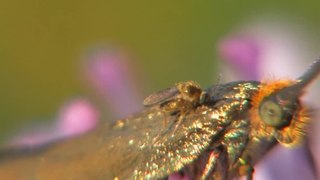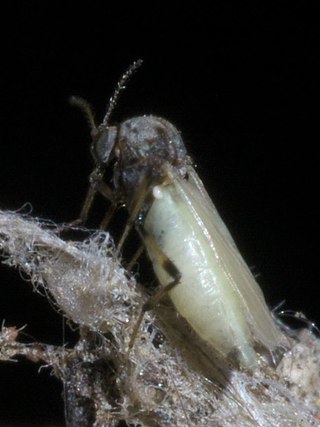
A midge is any small fly, including species in several families of non-mosquito Nematoceran Diptera. Midges are found on practically every land area outside permanently arid deserts and the frigid zones. Some midges, such as many Phlebotominae and Simuliidae, are vectors of various diseases. Many others play useful roles as prey for insectivores, such as various frogs and swallows. Others are important as detritivores, and form part of various nutrient cycles. The habits of midges vary greatly from species to species, though within any particular family, midges commonly have similar ecological roles.

Sandfly or sand fly is a colloquial name for any species or genus of flying, biting, blood-sucking dipteran (fly) encountered in sandy areas. In the United States, sandfly may refer to certain horse flies that are also known as "greenheads", or to members of the family Ceratopogonidae. The bites usually result in a small, intensely itchy bump or welt, the strength of which intensifies over a period of 5-7 days before dissipating. Moderate relief is achieved with varying success through the application of over the counter products such as Benadryl (ingested) or an analgesic cream such as After Bite. Outside the United States, sandfly may refer to members of the subfamily Phlebotominae within the Psychodidae. Biting midges (Ceratopogonidae) are sometimes called sandflies or no-see-ums. New Zealand sandflies are in the genus of sand fly Austrosimulium, a type of black fly.

Leptoconops torrens is a species of small biting flies in the no-see-um family Ceratopogonidae. They were first mentioned in writing by Charles Henry Tyler Townsend in 1893. The name Leptoconops carteri is a junior synonym of L. torrens. They are prevalent in the southwestern and southeastern areas of the United States. In early stages of life, L. torrens flies dwell in soil, then emerge to feed and breed as fully developed adults.

Ceratopogonidae is a family of flies commonly known as no-see-ums, or biting midges, generally 1–3 millimetres in length. The family includes more than 5,000 species, distributed worldwide, apart from the Antarctic and the Arctic.

The Chironomidae comprise a family of nematoceran flies with a global distribution. They are closely related to the Ceratopogonidae, Simuliidae, and Thaumaleidae. Many species superficially resemble mosquitoes, but they lack the wing scales and elongated mouthparts of the Culicidae.

Ceratopogonini is a tribe of biting midges, family Ceratopogonidae.

Leptoconops is a midge genus in the family Ceratopogonidae. It has a mostly tropical or subtropical distribution worldwide, but some species occur as far north as Moscow region in Russia and the Yukon Territory in Canada.

Austrosimulium is a subgenus of Austrosimulium, a genus of Simuliidae. The flies in this subgenre are found mainly in New Zealand, with a few in Australia. They are the only Simuliidae found in New Zealand.

Forcipomyia is a genus of biting midges in the subfamily Forcipomyiinae. Species of the subgenus Lasiohelea suck vertebrate blood. Some species are ectoparasites on larger insects. Other species in the genus are important pollinators of the cacao tree. There are at least 1,000 described species in Forcipomyia.
Leptoconops zherikhini is an extinct species of biting midges belonging to the family Ceratopogonidae. This species was described from fossilized remains preserved in Lower Cretaceous amber from Álava, Spain. These fossils represents the earliest known occurrence of extant genus Leptoconops.

Leptoconops nosopheris is an extinct species of biting midges belonging to the family Ceratopogonidae. This species was described from fossilized remains preserved in Burmese amber from the Early Cretaceous. The amber containing the fossil was mined in the Hukawng Valley, in Kachin State, Myanmar
Leptoconops gravesi is an extinct species of biting midge belonging to the family Ceratopogonidae. This species was described from fossilized remains preserved in Late Cretaceous amber from Vendée, France. The piece of amber containing the holotype specimen also preserved a scelionine wasp and an earwig nymph.
Leptoconops amplificatus is an extinct species of biting midge belonging to the family Ceratopogonidae. This species was described from fossilized remains preserved in Lower Cretaceous amber from Lebanon.
Forcipomyia fuliginosa is a species of biting midges.

Bezzia nobilis is a species of biting midges in the family Ceratopogonidae. It is widely considered one of the most common Bezzia species; it is found in Eurasian regions, all over the United States, Central America, and even into South American countries like Brazil. B. nobilis seem to prefer aquatic environments; they are commonly observed in stagnant water pools in Eurasia regions and marshes in the southern United States. Adults of this species are easily distinguished by their black and yellow striped legs. Pupae are recognized by their brown bodies, abdominal spines, and respiratory horns. B. nobilis larvae are distinguished by brown heads and white bodies. Little information is known on their life cycle or mating habits. B. nobilis is a predatory species. While some research suggests they mainly feed on larvae of other insect species, experiments suggest they prefer immobile, easy prey such as dead adult flies, bacteria, and protozoa.
Forcipomyia pictoni is a species of biting midges.
Forcipomyia glauca is a species of biting midges.
Mallochohelea atripes is a species of biting midges in the family Ceratopogonidae.
Allohelea johannseni is a species of predaceous midge in the family Ceratopogonidae.
Leptoconops kerteszi, common name Bodega black gnat, is a species of biting midges belonging to the family Ceratopogonidae. They feed on multiple species and can be found in places such as the United States, Egypt, and Tunisia.








